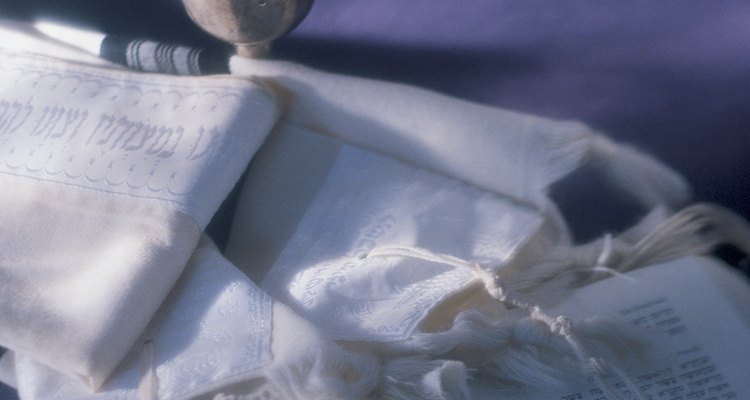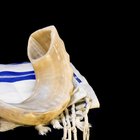
Comstock/Comstock/Getty Images
If you have ever been to a Jewish wedding or a service at a synagogue, you may have noticed a swath of cloth draped over the men's and sometimes women's shoulders. This is a prayer shawl, or tallit, a traditional garment worn by Jews to signify reverence and communication with God. The tallit shows that a dialogue has been opened between God and the wearer. Think of it as a spiritual uniform meant to inspire awe and respect for the task at hand. Someone wearing the tallit is actively engaged in matters of serious religious import.
Using the Tallit
A wedding ceremony is considered one of the most sacred rituals in Judaism. Traditions vary between sects and even within denominations but the tallit is familiar to all of them. A rabbi will most certainly wear a tallit when performing wedding rites. In a traditional Sephardic Jewish wedding, the groom wears the tallit for the ceremony after it is presented to him by his wife-to-be. Sephardic Jews are of Portuguese, Spanish or North African descent. Most Sephardic men do not wear a tallit until they are married, and the bride's gift symbolizes her part in her husband's cooperation with and deference to God.
Chuippah
During some ceremonies, a large tallit serves as the top of the chuppah, or wedding canopy. Even when a separate chuppah top is created, it is not unusual to incorporate the bridegroom's tallit or one used by his father or grandfather. Today it is not uncommon to see elaborate chuppah created specifically for the wedding, decorated in flowers and ornate vines. Before the introduction of these grand constructions, however, the tallit was used instead. Often the wedding couple is wrapped in a large tallit during the recitation of the seven blessings and benediction as a symbol of their unity.
Substituting the Kittel
An Ashkenazi Jew, one whose ancestors come from Western Europe, sometimes wears a kittel instead of a tallit. The kittel is a coat traditionally worn on High Holy Days, the most important holidays in the faith, at funerals, and, oddly, at weddings. The kittel's color, white, symbolizes purity, the chastity of the bride and the sanctity of the holy union. The kittel has no pockets, representing that the marriage is being entered into for love and not financial gain.
Tzitzit
A commandment from God prompted the Jews to adapt their talitot as vestiges for tzitzit, Hebrew for the four knotted fringes affixed to each corner of the cloth. God instructed Moses that every Jew must wear tzitzit as a demonstration of faith. Although there are cosmetic differences between the talitot of different Judaic sects, talitot are usually rectangular-cut and made from cotton, linen or silk -- never a mixture of linen and wool, though, as this is strictly forbidden by the Torah. The ideal tallit is made of coarse, half-bleached lamb's wool. Embroidered strips on one side show where the tallit should meet the neck.
Related Articles

The Meaning of Exchanging Wedding Rings

Wedding Blessing Etiquette

How to Use a Veil & Cord in a Wedding

Mexican Wedding Traditions

Romanian Orthodox Wedding Traditions

What Religions Do Not Allow You to Have ...

Why Do Brides Wear Veils?

Muslim Wedding Etiquette

Traditional African Wedding Attire

What Is the Meaning of the Tassels of ...

How to Wear a Prayer Shawl

Mexican Catholic Wedding Traditions

What Do Wedding Ushers Wear?

Bride & Groom Dress Etiquette for a ...

What Is the Benediction in a Wedding ...

What Do Chinese Women Wear?

Quinceanera Rituals

A Guide to Preparation for a Hindu ...

Seventh Day Adventist Wedding Ceremony

Proper Wedding Attire for the Wedding ...
References
Writer Bio
Anthony Jacobson is a Florida writer working extensively in the genres of nonfiction, personal essay and memoir. He is an associate editor for the Hollerbox literary journal and a contributor to the writing life and culture podcast, "The Drunken Odyssey" with John King.
Photo Credits
Comstock/Comstock/Getty Images